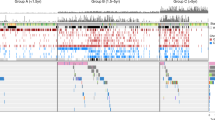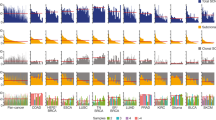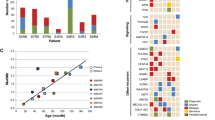Abstract
Chromosomal aberrations of 20 stage 4s neuroblastomas were analysed by comparative genomic hybridization (CGH). In a subset of 13/20 tumours, telomerase activity was evaluated by the telomeric repeat amplification protocol (TRAP). The CGH data were compared with the CGH results of ten stage 1 and 2 (stage 1/2) and 22 stage 3 and 4 (stage 3/4) neuroblastomas. A total of 17/20 stage 4s neuroblastomas did not progress clinically, whereas tumour progression with lethal outcome occurred in 3/20 cases. The CGH data of clinically non-progressing stage 4s tumours revealed a high rate of whole-chromosome aberrations (73.4%) with an overrepresentation of mainly chromosomes 2, 6, 7, 12, 13, 17, 18 and an underrepresentation of mainly chromosomes 3, 4, 11, 14. MYCN amplification or 1p deletion was observed in only 1/27 or 2/17 clinically non-progressing stage 4s tumours respectively, whereas all three progressive stage 4s neuroblastomas showed MYCN amplification, 1p deletion and, in 2/3 cases, distal 17q gains. Except for one case, telomerase activity was not observed in non-progressing stage 4s neuroblastomas. In contrast, 4s tumours with lethal outcome revealed elevated telomerase activity levels. Our data suggest that stage 4s neuroblastomas belong to two biologically different groups, one of which displays the genetic features of localized stage 1/2 tumours, whereas the other mimics advanced stage 3/4 neuroblastomas.
This is a preview of subscription content, access via your institution
Access options
Subscribe to this journal
Receive 24 print issues and online access
$259.00 per year
only $10.79 per issue
Buy this article
- Purchase on Springer Link
- Instant access to full article PDF
Prices may be subject to local taxes which are calculated during checkout
Similar content being viewed by others
Author information
Authors and Affiliations
Rights and permissions
About this article
Cite this article
Brinkschmidt, C., Poremba, C., Christiansen, H. et al. Comparative genomic hybridization and telomerase activity analysis identify two biologically different groups of 4s neuroblastomas. Br J Cancer 77, 2223–2229 (1998). https://doi.org/10.1038/bjc.1998.370
Issue Date:
DOI: https://doi.org/10.1038/bjc.1998.370
This article is cited by
-
Stage 4 s neuroblastoma: features, management and outcome of 268 cases from the Italian Neuroblastoma Registry
Italian Journal of Pediatrics (2019)
-
Comparison of different techniques for the detection of genetic risk-identifying chromosomal gains and losses in neuroblastoma
Virchows Archiv (2008)
-
Chromosomal CGH identifies patients with a higher risk of relapse in neuroblastoma without MYCN amplification
British Journal of Cancer (2007)
-
Prognostic value of the International Neuroblastoma Pathology Classification in Neuroblastoma (Schwannian stroma-poor) and comparison with other prognostic factors: a study of 182 cases from the Spanish Neuroblastoma Registry
Virchows Archiv (2006)



